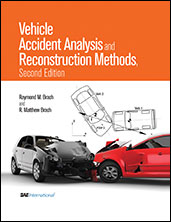Technical Paper
Analysis of Collisions Involving Articulated Vehicles
2007-04-16
2007-01-0735
In the vast majority of impacts involving light vehicles, traditional impulse-momentum collision models can be used to analyze the mechanics of two colliding vehicles. However, these models cannot handle the multiple degrees of freedom associated with articulated (pin-connected) vehicles. In addition, collisions involving one or two articulated vehicles may not satisfy the basic assumptions of these traditional collisions models. In particular, the assumption that impulses of external forces (such as tire-road friction) are negligible compared to the impulse developed over the crash surface may not be valid. The large masses, long dimensions, the presence of the pinned joint, or all of these factors, may necessitate special considerations and more flexible model capabilities. This paper lists the assumptions that underlie the application of the principle of impulse and momentum to a planar collision between rigid bodies.


